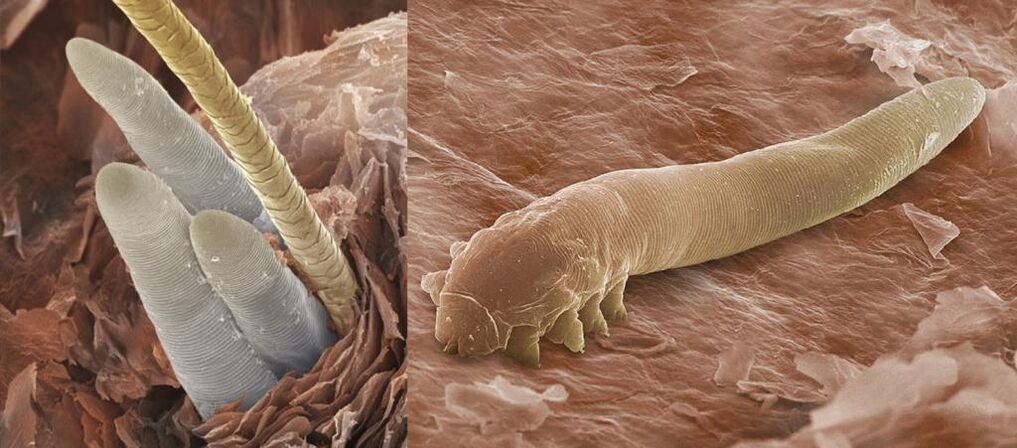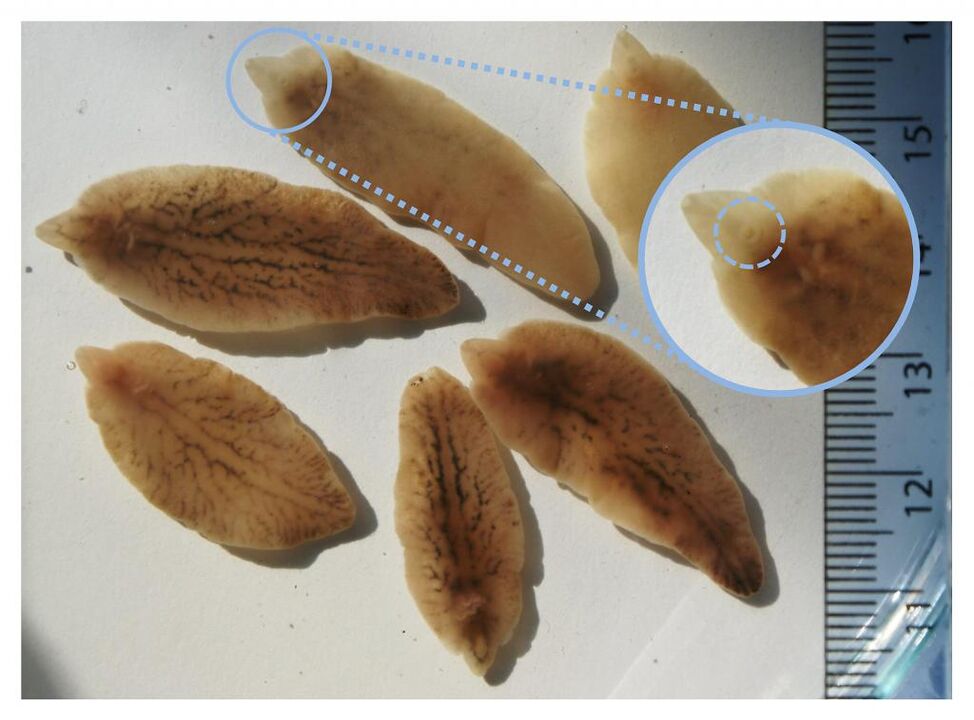Parasitic infections represent a variety of symptoms and illnesses caused by the entry of eggs or adult worms into the human body.Often, it takes days, and in some cases, months or even years for the first symptoms of the disease to be noticed.This is due to the parasite's life cycle and its main functions: good camouflage and maintaining itself alive by receiving nutrients from the host's body.
Types of parasites and their characteristics
Parasitic infections are divided into three groups according to certain characteristics of their manifestations:
- External parasites.
The main site is the human body surface.These include lice, fleas, ticks and bed bugs.They feed primarily on human blood, although in some cases, such as the mites that cause demodicosis, the main food is secretions from sebaceous glands or dead epithelial (skin) cells. The first signs of parasitic infection are easy to recognize as they cause itching and burning sensations in the habitat.Some ectoparasites are carriers of serious diseases: typhus, anthrax, encephalitis, and trypanosomiasis.They cause enormous damage to human health, including death.
The first signs of parasitic infection are easy to recognize as they cause itching and burning sensations in the habitat.Some ectoparasites are carriers of serious diseases: typhus, anthrax, encephalitis, and trypanosomiasis.They cause enormous damage to human health, including death. - Internal parasites (protozoa).
Mainly affects internal organs.They are single-celled structures and hence are called protozoa.Still, they can cause serious illness.The main diseases in this group are parasitic blood infections caused by Toxoplasma gondii and intestinal infections caused by amoeba or Giardia. - worm.
They are the causative agents of the most common forms of parasitic infections.In humans, their developmental cycle occurs primarily in the intestines and tissues, where the manifestation of disease symptoms begins.
Roundworms (nematodes)
These are parasites whose bodies are round in cross-section.Gender characteristics are easily distinguished.Females are usually larger than males.But representatives of this category also include hermaphrodites.All nematodes go through developmental stages: egg, larvae, and adult.This category includes:
- Pinworms.The disease is caused by pinworms.It mainly affects children of preschool and primary school age.
- Whipworm.Causes whipworm disease.Has a unique body shape.2/3 of the body length is very thin in diameter, reminiscent of human hair or thread.The other end of the body is larger in diameter and contains the intestines.
- roundworms.The disease is caused by roundworms.Adults can reach a size of 25 cm (males) and 40 cm (females).After the larvae enter the human body, they pass through the stomach and enter the small intestine.From there, as the blood flows, it travels through the pores to the liver, then to the heart, and then to the lungs, where it develops over a period of 7-10 days.The larvae then begin to ascend into the throat.Once they reach the mouth, they are re-swallowed.Once in the small intestine, the larvae are unable to re-enter the bloodstream through the pores due to their large size.There they will reach adulthood in 2-3 months.After this, reproduction begins and the cycle repeats.Females can lay more than 200,000 eggs per day.

Tapeworm (Tapeworm)
The bodies of these parasites resemble the shape of a ribbon.A distinctive feature of this animal is that it has no digestive system.These include:
- Echinococcus tapeworm.The disease is caused by hydatid disease.This parasite is small (2-9 mm) and consists of several segments and suckers.The uterus of a sexually mature individual contains a large number of eggs containing larvae.The main localization sites of Echinococcus are the liver and lungs.There, it can cause a chronic condition called hydatid cyst.
- Bull tapeworm.Cause tinea pedis.In the larval stage, it has an intermediate host - cattle.Once in the body, it develops to the band-like stage in the small intestine.The body of an adult insect has as many as 1,000 segments and can reach a length of 4-10 meters.
- Pork tapeworm.Causes taeniasis.In appearance, it is very similar to the bull tapeworm.It also has intermediate hosts: pigs, dogs, camels, hares and domestic rabbits.In humans, it is a parasite in the intestines.The length of an adult individual does not exceed 4 meters.
- Tapeworms are very wide.The disease is caused by diye filariasis.Live in fresh water bodies.It uses crustaceans and fish as intermediate hosts.In humans, it lives in the small intestine.Adults can reach several meters in length.
Flatworms (flukes)
During their life cycle, these parasites can change several intermediate hosts.In humans, they can colonize any organ.This group includes:
- Schistosomiasis.The disease is caused by schistosomiasis.They can enter the body through contact with contaminated fresh water.The parasite penetrates the skin and enters the circulatory system, where it actively reproduces.Females can lay 300 to 3,000 eggs per day.Furthermore, as the blood flows, the eggs spread throughout the body and continue to develop in any organ.Their body length does not exceed 0.1-0.2 cm.
- Liver flukes.The disease is caused by opiodriasis.Adult body length varies from 3 to 5 cm.After entering the human body, it parasitizes the bile duct, gallbladder, liver and pancreas.It is anchored in these organs using suction cups located on the body.

How parasites invade the human body
- The nutritional route of infection is thought to be the most common.A person gets the parasite by eating unwashed vegetables and fruits.Meat that has not been adequately heat treated is particularly dangerous.In addition, if personal hygiene rules are not followed, a person can become infected with parasites.For example, not washing your hands before eating.
- Transplacental route.Parasitic infections are transmitted from a pregnant woman to her child through the placenta.For example, diseases such as toxoplasmosis, malaria or hookworm.
- Transcutaneous route.Parasites enter the body through the skin.These are mainly schistosomiasis and hookworms.
- Contact path.Parasites are spread through dirty hands, contaminated personal items and underwear.This is how lice, scabies, and pinworms are most commonly spread.
- transmission path.Infection occurs after being bitten by an insect that carries the parasite.For example, malaria.
symptom
Many parasitic diseases have no symptoms in their early stages.This is due to the stage of development of the pathogen.Each type of parasite exhibits different characteristics as it grows.Common symptoms of parasitic infections include:
- itching.
- Redness of the skin, like hives.
- diarrhea.
- constipate.
- Flatulence.
- Nausea, vomiting.
- Gastrointestinal cramps and pain.
- Weight loss can be achieved without dieting or increased physical activity.
- Fever condition.
- Exposure to high body temperature (38-40℃) for a long time.
- Prolonged dry cough.
- Swollen lymph nodes.
- Feeling of muscle pain.
- Psycho-emotional disorders.
diagnosis

If you suspect parasitic disease, you must undergo a series of tests.Diagnosis of parasitic infections allows us to determine whether parasites are present, their type and their location in the body.The data obtained will help doctors make the right diagnosis and prescribe the right treatment.
Diagnostic methods include:
- Fecal examination.Allows you to determine whether most types of parasites are present in your intestines.Their eggs, larvae and body parts are excreted in feces.There are two types of analysis:
- Check stool samples for worm eggs and larvae.The results of the analysis are sent to a laboratory, where a doctor makes a smear and examines it under a microscope.This method is often used, but is not accurate enough.To make a final diagnosis, patients must undergo this test up to three times at short intervals.This is due to the life cycle and egg-laying of the parasites detected by the methods of this study.
- Scrape (clean) from the anal folds.This test only detects one type of worm - pinworms.Parasitic infections are more common in children than in adults.Therefore, this analysis was conducted mainly on children.The lab technician moistens a cotton swab or glass eye swab with water or glycerin and then irrigates the perianal folds.Next, the resulting material is spread on a glass slide and examined under a microscope.This analysis is also done using a different method: a lab assistant sticks a piece of tape to the anal passage, presses on it and peels it off.The tape is then placed on a glass slide and viewed under a microscope.The diagnosis of parasites is quite accurate.Using these methods, laboratory assistants are able to examine not only worm eggs, but sometimes adult individuals as well.
- Examine cerebrospinal fluid, sputum, duodenal contents (bile), and urine.Prescription based on patient survey results to determine the presence of parasites and locate their location.These biological fluids are analyzed using microscopy and macromicroscopy.First, the resulting samples are examined for the presence of adult individuals, and then microscopic examination is performed to detect eggs and larvae of the parasite.
- blood test.Modern methods of detecting parasitic infections in the blood can determine the presence and type of pathogen with high accuracy.Three types of such diagnostics are used:
- Serological response.Allows you to determine whether parasite antibodies are present in the patient's serum.This method is considered highly specific, but not as good as PCR diagnostics.
- PCR diagnostics.The method is based on the identification of parasite DNA in any biological fluid used for analysis.
- Genetic research.It involves detecting the genome of parasites in patient blood samples.This method is used much less frequently than all other methods, but is highly accurate.
- Examine biopsy material and lymph nodes.To perform this analysis, doctors remove a small portion of an organ, tissue, or an entire lymph node and send it for histological examination.In this way the presence of parasites can be diagnosed.
Tips for preparing for testing
Before being tested for a parasitic infection, you need to be properly prepared.If recommendations are followed, diagnostic accuracy increases because the material does not contain confounding factors that affect the validity of the research method.
Prepare for a stool test:
- Antibiotics, anti-inflammatory drugs, and antacids should be discontinued.The use of medications and other medications containing bismuth and iron is also unacceptable.
- If a barium meal X-ray or colonoscopy is performed during which an enema is given to clean the intestines, a stool test can only be performed 2-3 days later.
- Donating stool is not recommended if menstrual bleeding begins or if hemorrhoids worsen.
Prepare for a blood test:
- It is necessary to stop taking medications that affect blood cell counts.
- Three days before the examination, you should eat a light diet, avoid greasy food, and abstain from alcohol.
- Blood tests for parasite infections are done on an empty stomach.Small amounts of clean drinking water are allowed.
For other tests, no special preparation is usually required.You just need to follow your doctor's advice.
treat
Unfortunately, symptoms of parasitic infection are not always detected in the initial stages of the disease.In this case, treatment begins late.It’s important to understand: the longer the parasite stays in the body, the more difficult it is to get rid of it.
Treatment of infectious and parasitic infections is divided into two areas:
- Symptomatic treatment.Aims to eliminate clinical manifestations of disease.These include lowering body temperature, eliminating redness and itching, and normalizing gastrointestinal function.
- Treatment of the cause of a parasitic infection is aimed at eliminating the causative agent of the disease.
In some cases, surgery may be needed.Suitable for alveolar coccosis, hydatid disease and some types of fluke infections.
When the body is dehydrated, saline solutions should be used.
Only a doctor can prescribe treatment for a parasitic infection based on laboratory tests and patient interviews.
prevention
Observation and prevention of parasitic infections is very important.In most cases, this will help prevent pathogens from entering the body.

Preventive measures include:
- Observe the rules of personal hygiene: you must wash your hands before eating, after using the toilet and coming home from the street.
- Vegetables and fruits should be washed.
- Adequate heat treatment of meat, fish and seafood is imperative.
- Tap water should not be used as drinking water as it may not always be free of parasites.Using a household filter as an extra cleaning won't help.Your best option is to drink boiled or bottled water.
- If the pet lives at home, it will need to be dewormed every six months.You should also limit contact with your pet and contact a veterinary clinic if it shows signs of parasitic disease.
- Underwear (especially children's underwear) should be ironed after washing.
- After a visit to a foreign country, when working on the land, and when working as an employee in a children's institution, it is recommended to check for the presence of parasitic infections once a year and, if necessary, to use pharmacological prophylaxis.

























